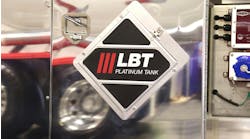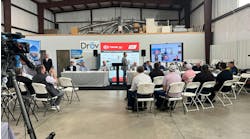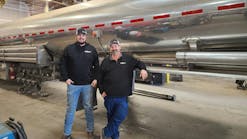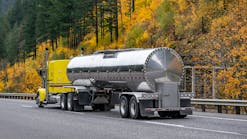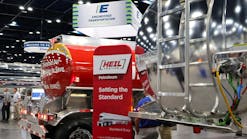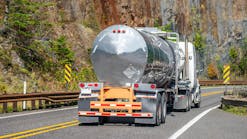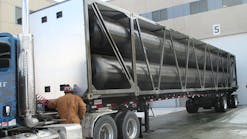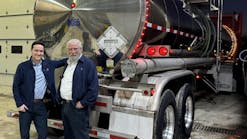By the end of last year, the executive committee of the Truck Trailer Manufacturers Association was expected to approve a technical bulletin of best practices cargo tank owners can use to test pressure relief valves and re-qualify service, according to Dave Girard, vice-president of Girard Equipment Inc.
Girard said bench testing is a test to determine function that is performed at a convenient location off the cargo tank that is normally attached to the reclosing pressure-relief valve, which is designed to open at a given pressure, relieving that pressure from a tank and reclosing once the pressure drops sufficiently.
“These are also known as vents, pressure actuated fills (PAF), and emergency vents,” he said during the National Tank Truck Carriers 2012 Tank Truck Show & Maintenance Seminar October 22-24 in Louisville, Kentucky. “Sometimes there's confusion over this.”
A pressure-relief device is any device designed to automatically relieve pressure from a tank at a predetermined set of conditions, he said. They include reclosing pressure-relief valves and non-reclosing devices such as fusible caps, fusible plugs, and rupture discs. The Maximum Allowable Working Pressure (MAWP) of the cargo tank is stamped on the tank's specification plate, and is also known as the design pressure on MC300 series tanks.
Properly functioning pressure-relief valves are important to the safe operation of a cargo tank, Girard said.
During external visual inspection and testing, §180.407(d)(3) states:
“All reclosing pressure relief valves must be externally inspected for any corrosion or damage which might prevent safe operation. All reclosing pressure relief valves on cargo tanks carrying lading corrosive to the valve must be removed from the cargo tank for inspection and testing. Each reclosing pressure relief valve required to be removed and tested must open at no less than the required set pressure and no more than 110% of the required set pressure, and must reseat to a leak-tight condition at no less than 90% of the start-to-discharge pressure or the pressure prescribed for the applicable cargo tank specification.
During a pressure test, §180.407(g)(1)(ii) states:
“All self-closing pressure-relief valves, including emergency relief vents and normal vents, must be removed from the cargo tank for inspection and testing. Each self-closing pressure-relief valve that is an emergency relief vent must open at no less than the required set pressure and no more than 110% of the required set pressure, and must reseat to a leak-tight condition at no less than 90% of the start-to-discharge pressure or the pressure prescribed for the applicable cargo tank specification. Normal vents (1 psig vents) must be tested according to the testing criteria established by the valve manufacturer. Self-closing pressure-relief devices not tested or failing the tests in this paragraph must be repaired or replaced.”
“On a pressure test, you're testing the pressure-relief valve, assessing where it opens and where it reseats, and then you have to make a determination whether you will re-qualify,” Girard said. “We hope this (TTMA) document will eliminate confusion and make it as concise as possible.”
A bench test set-up shall consist of a test chamber (a small volume or tank to hold air pressure), a mount (means to securely attach the pressure-relief valve to the test chamber), and air control (a means to controllably introduce, measure, and exhaust pressurized air into and out of the test chamber).
The test chamber can be a small air receiver tank, a pipe nipple with one end sealed, a manhole ring welded to blanked plate, or similar system. The volume enclosed by the tank should be as small as practical in order to reduce the total energy contained in the compressed air for the test as well as to speed testing.
The test chamber should be strong enough to withstand, without deformation or cracking, at least 150% of the highest set-pressure-relief valve possibly tested. The vessel shall be protected from seeing pressures in excess of this level by a pop-safety valve regulating the air inlet, such that if a valve under test fails to open at all and the air inlet is kept open, the test chamber will safely contain the pressure.
There usually is a means of duplicating the mount used to attach the reclosing pressure relief valve to the tank. A threaded nipple or a weld collar and clamp ring are typical examples. The mount shall secure the valve to be tested to the test chamber in such a way that it can withstand the highest possible forces from pressure for which the test chamber is designed. The mount shall also include a means of forming a pressure-tight seal between the test chamber and valve, usually a rubber gasket or the like. The mount should hold the valve to be tested in the same attitude as when it's installed on the tank.
Air control valves, exhaust valves, pop-safety valves and pressure gauges shall be located in such a way as to protect the operator performing the test from dangerous expulsions of air and debris from exhausted air, sudden opening of the tested valve, etc. Air control fittings should be as small as practical to provide reasonable air flow into and out of the test chamber; ¼" NPT is typical. All fittings shall be pressure rated at least as much as the test chamber.
The inlet shall consist of a valve for controlling compressed air into the test chamber. Air coming in should be regulated to a maximum of the pressure the test chamber was designed for. The exhaust shall consist of a valve that can exhaust the test chamber to atmosphere. The pressure gauge: Shall be connected to the test chamber to read the pressure within. Full scale on the gauge should be no more than the pressure the test chamber was designed for. Full scale should also be less than five times the lowest pressure being measured.
The pressure gauge should be calibrated to verify it is reading true any time it is suspected of reading wrong or at least annually. Example: A test chamber designed to test up to 40 psig valves and thus at least strong enough to withstand 60 psig should have a gauge with a top reading of no more than 60 psig. That 0-60 psig gauge should not be used to measure opening or reseating less than 12 psig.
Pre-test checks:
- Determine the cargo tank specification (DOT 407, MC 307, etc) and Maximum Allowable Working Pressure (MAWP) of the cargo tank to which the reclosing pressure-relief valve is mounted. Determine the manufacturer and model number for the valve, the stamped set pressure and the specification for which the valve was made.
- The reclosing pressure-relief valve shall be removed from the tank and inspected for damage, corrosion, or clogging. If the valve is not clean, it shall be cleaned to remove any chemical residue or build-up. Only valves appearing in good order shall be tested. Consult with the valve manufacturer to determine out-of-service conditions for a given valve design.
- The connection between the valve and the tank shall be fully open to the tank with no obstructions or reductions in diameter unless approved in writing by the valve manufacturer.
- Mount the reclosing pressure-relief valve. Use appropriate gaskets to ensure that there is no leak between the valve and the test chamber.
- Gradually increase the pressure. Open the inlet valve such that the pressure in the test chamber is going up on the pressure gauge at about 20% of full scale every 10 seconds, or approximately as fast as the second hand on a watch. Look and listen for any leaks around the mounting of the valve: if detected, close the inlet valve, open the exhaust valve and adjust the valve's mount as required.
- Detect and note the actual opening pressure. Consult with the valve manufacturer on the level of detection required: some manufacturers use a “start-to-leak” pressure for their vents and will use a leak detection fluid to reveal opening pressure, while most others use a pressure of “continuous flow” as determined by seeing, feeling or hearing. Use the recommended method to detect the actual opening pressure and note it. If the pressure is outside the range allowed, it must either be repaired or replaced.
- Close the inlet and observe for reseating pressure. Once new air is not being introduced to the test chamber, the valve will continue to allow some air to escape and the pressure to fall. Wait until the gauge is longer falling. This is the reseating pressure. If the reseating pressure is below the minimum reseating pressure, it must be either repaired or replaced.
- Open the exhaust valve and allow the test chamber pressure to fall to completely. Remove the pressure relief valve.
Girard said test reports should note the following: pressure-relief valve manufacturer and model number, stamped set pressure, tested opening pressure and tested reseating pressure. Finally, note the disposition of the valve: If it failed any of the tests, note that it's either repaired or replaced. Otherwise, note it as OK to remount.
“Reporting is nearly as important as the actual test,” Girard said. “If you don't record what you've done, the procedure is flawed.”
“If the valve needs repair, the valve manufacturer should be contacted for directions on how to repair the valve. Once repaired, the valve should be tested as if it was just removed from the tank to prove the effectiveness of the repair. If the valve cannot be repaired, it shall be replaced. If the valve is OK to remount, or a replacement is selected, mount the pressure relief valve on the tank using the appropriate gaskets/seals.”
